11.2 Importing a Library, a Driver Set, or Driver from the Identity Vault
To import an eDirectory object, you must have access to the eDirectory tree that is associated with the Identity Vault.
11.2.1 Associating a Server to the Identity Vault
When you add a new Identity Vault to a project, you see the Add Server Association window, where you can accept the default server, specify a server, or browse to a server. The import and deploy features use the server association for later identification. To do this:
-
In the Modeler view, drag an Identity Vault icon from the Palette to the Modeler view to bring up the Add Server Association window.
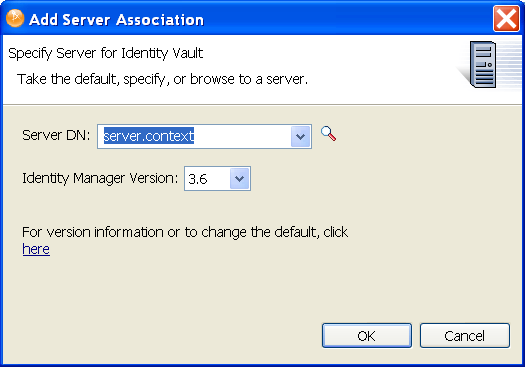
Type the server’s DN context in the field, or click .
-
If you select , fill in the appropriate host name, user name, and password in the Credentials to Identity Vault window. Click .
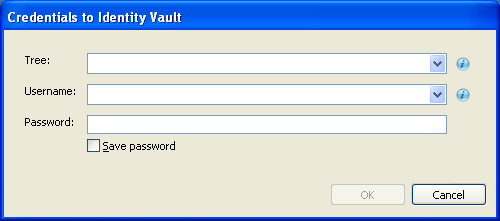
-
In the Browse for Server Object window, select the server you want to associate with this driver set and click .
In the Add Server Association window, you also see the Identity Manager version displayed. This is important when importing and exporting driver sets and drivers, because you must match driver sets and drivers to the correct Identity Manager version.
-
Click the entry for more information.
-
Click to close the Add Server Association window and add an Identity Vault to your Modeler view.
11.2.2 Importing a Library from the Identity Vault
-
Right-click the Identity Vault in the Modeler view, then click .
-
(Conditional) If you have not yet provided authentication information, specify it now. In the Identity Vault Credentials window, fill in the host name, the user name and password information, then click .
Use the drop-down lists if they apply to your connection and user information. The option allows Designer to keep password information for future connections to this Identity Vault. Otherwise, you will see the Identity Vault Credentials page the next time you open Designer.
-
On the Import from Identity Vault page, browse to the Library object by clicking the button.
-
Select the Library object and click .
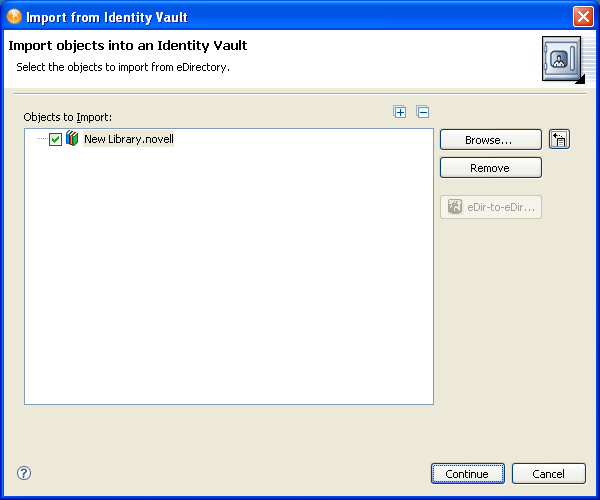
The library is added to the Import from Identity Vault page.
-
Click , then click to import the library.
-
On the Import Results page, click .
11.2.3 Importing a Driver Set from the Identity Vault
To import an Identity Manager Driver Set object (and all contained drivers) into an Identity Vault object in the Modeler view:
-
Right-click the Identity Vault in the Modeler view, then click .
-
(Conditional) If the Driver Set that comes with the Identity Vault creation is empty, you are asked if you want to remove the default Driver Set icon from the selected Identity Vault. Click .
-
(Conditional) If you filled out the authentication information when you initially created an Identity Vault icon in the Modeler view, go to the Properties view under the Project view. Specify authentication credentials for the selected Identity Vault, then skip to Step 5.
-
(Conditional) If you have not yet provided authentication information, specify it now. In the Identity Vault Credentials window, fill in the host name, the user name and password information, then click .
Use the drop-down lists if they apply to your connection and user information. The option allows Designer to keep password information for future connections to this Identity Vault. Otherwise, you will see the Identity Vault Credentials window the next time you open Designer.
-
In the Import from Identity Vault window, browse to the driver set by clicking the button.
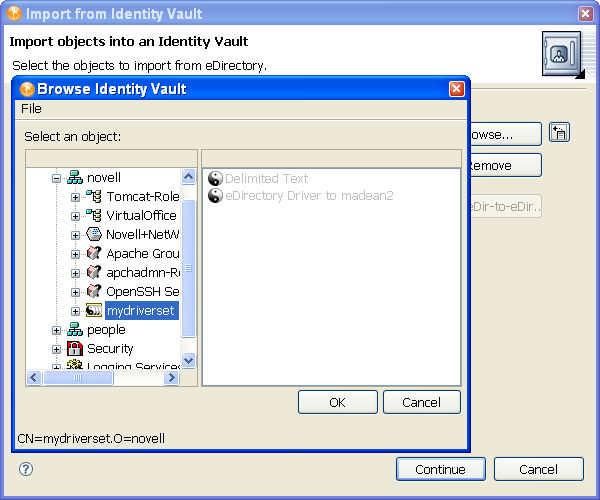
-
Select the driver set you want to import, click to place the driver set in the Objects to Import list in the Import Driver Set from eDirectory window. You can then deselect the drivers you do not want to import by deselecting the box next to the driver name. If you chose the wrong driver set, select the driver set and click . Otherwise, click .
You can import multiple driver sets during the import operation. Just browse to the various objects that you want to import and add them to the list.
Driver sets that are not associated with a server have a red minus in the lower right portion of the driver set icon. These driver sets need a server association in order to be deployed. An error displays if the application can’t authenticate to the eDirectory tree you have selected.
-
(Conditional) If you are importing one or more eDirectory drivers, select the eDirectory driver in the Objects to Import window, then click the button.
-
(Conditional.) If you fill out the user name and password and click to import both eDirectory drivers, you then see a Browse Identity Vault window where you select the corresponding eDirectory driver. Select the driver and click .
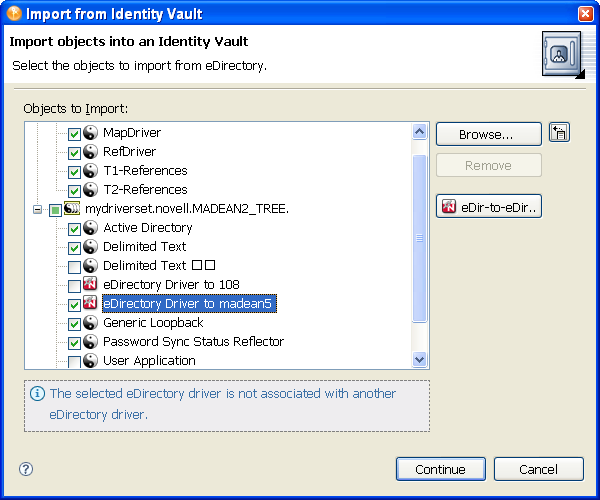
You are returned to the Import Driver Sets from eDirectory window, where you can select or deselect the drivers, allowing you to choose only the drivers in a driver set that you want to import.
-
Click . This brings up the Import Summary window, where you can see all of the Driver Set objects that are being imported into Designer. This summary uses the same format as the Compare window (see Section 11.5, Using the Compare Feature When Importing for further information). Click to continue.
-
(Optional) As the import operation progresses, you are asked to associate a server with the Identity Vault. Select the option that best suits your needs.
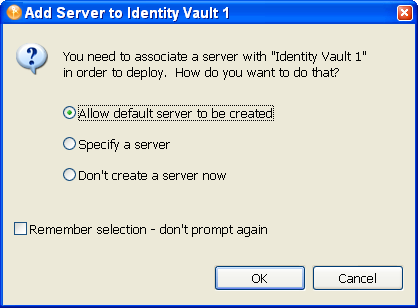
-
Allow default server to be created: Creates a dummy server with global configuration values and other elements that are associated with this project until you specify an actual server for the project. Make sure you have designated a correct Identity Vault server when you deploy the driver set.
-
Specify a server: Brings up the credentials screen, allowing you to designate a host server, a user name, and password for the Identity Vault server for this project.
-
Don’t create a server now: Skips all associations for this project. You need to fill in the host information before you deploy this driver set.
-
Remember selection - don’t prompt again: Continues to use whatever server option you chose the next time Designer needs to associate a server with an Identity Vault.
-
-
After you decide your plan of action and select the option you want, click to continue the import procedure.
-
Click .
If you selected in Step 7 to connect eDirectory drivers, you can view the complete data flow between the two eDirectory drivers, as well as the other drivers you selected.
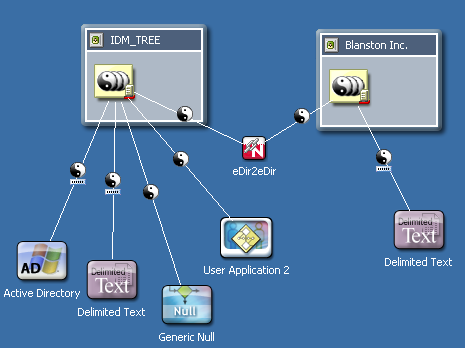
When the driver set imports, you see the Import Results window, showing you if there were any problems with the import procedure.
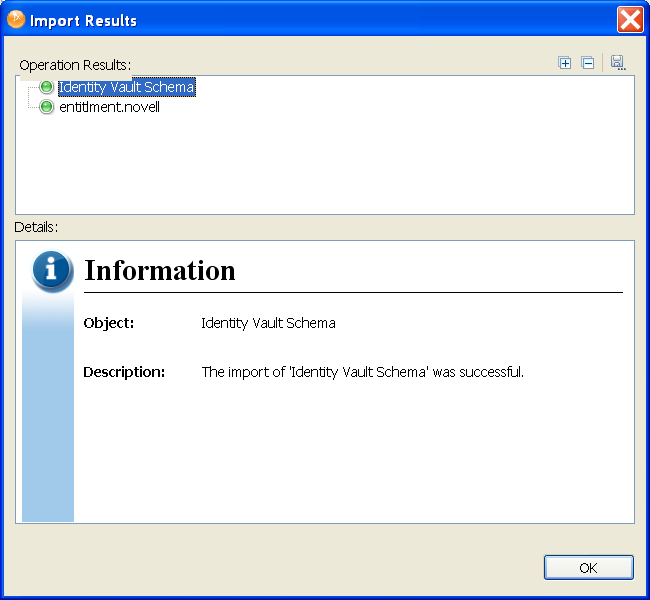
Errors during the import procedure are displayed with a red icon, and you see an Error description that is related to the operation results. If you have multiple errors, selecting an error displays the error’s description in the field. See Error Messages and Solutions for further information.
-
Click to finish the import process.
11.2.4 Importing a Driver from the Identity Vault
To import an Identity Manager Driver object (and all contained channels and policies) into a driver set:
-
Select an Identity Vault in the Modeler view. If you have added a new Identity Vault to a project, see Section 11.2.1, Associating a Server to the Identity Vault first, then return to Step 2.
-
Verify that the authentication credentials in the Properties view for the Identity Vault are correct.
-
Right-click a DriverSet object within the Identity Vault, then select > .
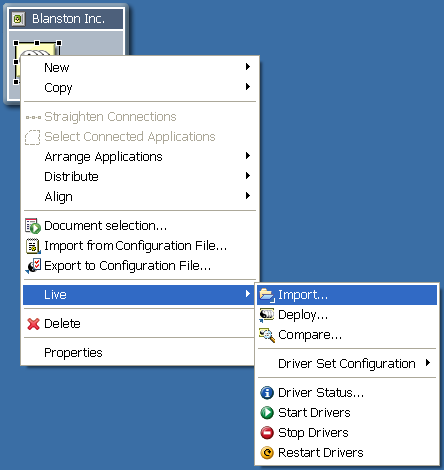
-
(Conditional) If the Identity Vault is not authenticated to the eDirectory tree, you see the Identity Vault Credentials window asking for the hostname, username and password. Provide the information, then click .
-
In the Import from Identity Vault window, click to select a Driver object from the Identity Vault.
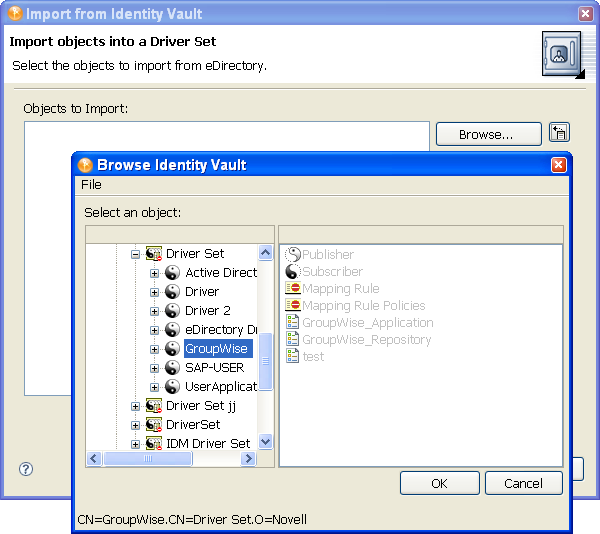
-
Click to place the driver in the Import from Identity Vault window, then click to install the driver and bring up the Import Configuration window.
-
In the Import Configuration window, select to edit the driver configuration, or select to close the Import Configuration window. Most drivers cannot run with default values. You need to modify the driver configuration values and parameters so the drivers can work properly in your network environment.
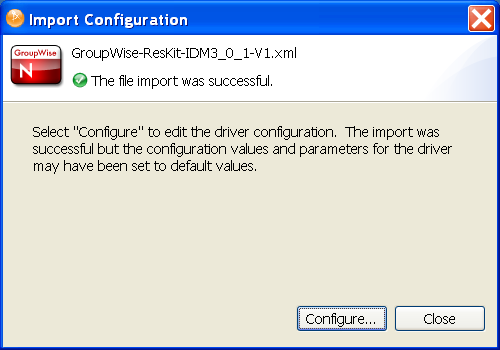
NOTE:You also see the Import Configuration window when you drag an application from the Palette to a driver set in the Modeler view.
-
When you select , the driver’s Property page with the option is displayed. Fill out the required values and parameters that are necessary to have the driver run in your network environment.
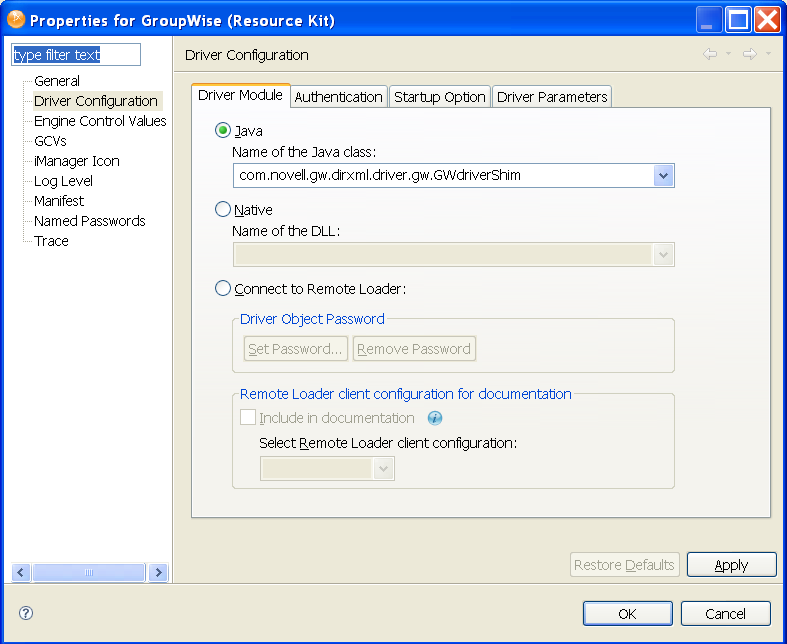
The two required options for every driver are and . However, because each driver contains different values and parameters, you need to consult the driver manual for specific values. Go to the Identity Manager Drivers web site, then select the manual for the driver you are configuring.
-
(Conditional) If you are importing one or more eDirectory drivers, Novell recommends that you connect to those eDirectory drivers during the import process. Select the eDirectory driver in the Objects to Import window, then click the button.
-
(Conditional) Fill out the user name and password for the other eDirectory tree and select to import both eDirectory drivers.
-
(Conditional) In the Browse Identity Vault window, select the corresponding eDirectory driver, then select the driver and click . You are returned to the Import Drivers from eDirectory window.
When the driver imports, you see the Import Results window showing you if there were any problems with the import procedure.
Errors during the import procedure are displayed with a red icon, and you see an Error description that is related to the operation results. If you have multiple errors, selecting an error displays the error’s description in the field. See Error Messages and Solutions for further information.
-
Click to finish the import process.